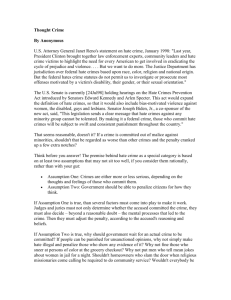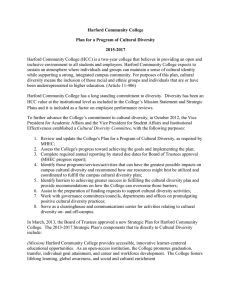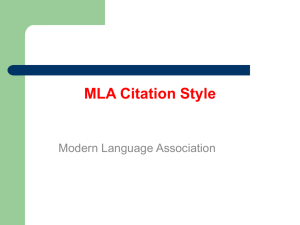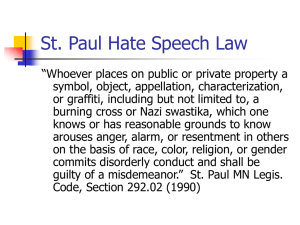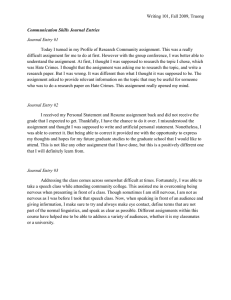Who’s to Blame? Sexual Orientation and Hate Crimes
advertisement
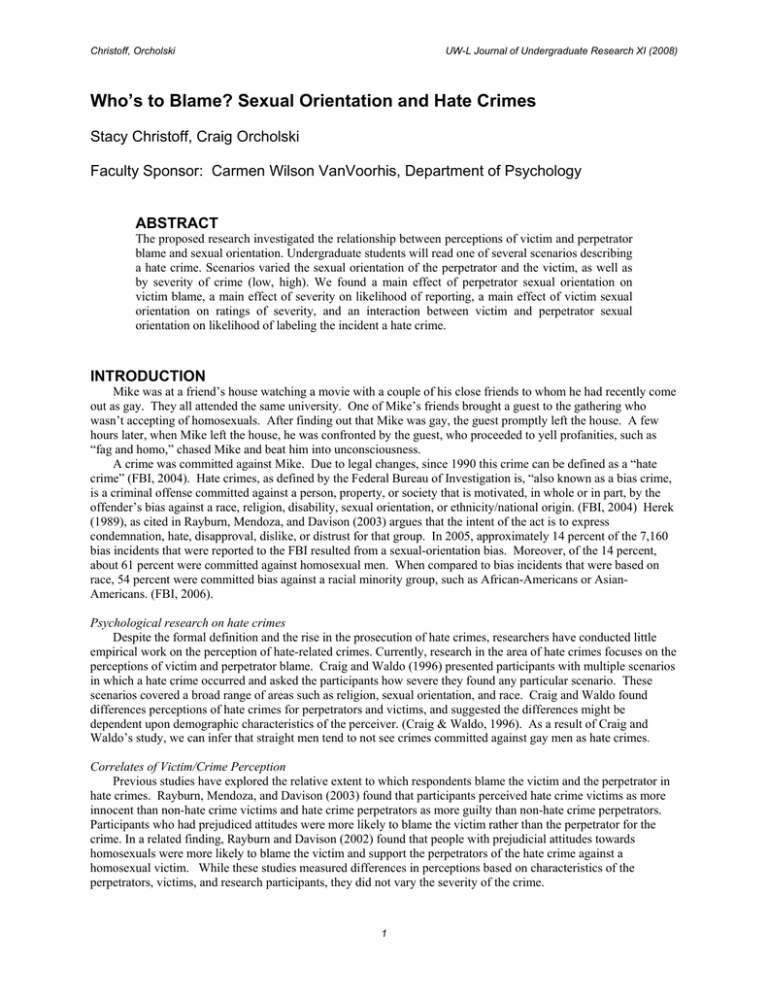
Christoff, Orcholski UW-L Journal of Undergraduate Research XI (2008) Who’s to Blame? Sexual Orientation and Hate Crimes Stacy Christoff, Craig Orcholski Faculty Sponsor: Carmen Wilson VanVoorhis, Department of Psychology ABSTRACT The proposed research investigated the relationship between perceptions of victim and perpetrator blame and sexual orientation. Undergraduate students will read one of several scenarios describing a hate crime. Scenarios varied the sexual orientation of the perpetrator and the victim, as well as by severity of crime (low, high). We found a main effect of perpetrator sexual orientation on victim blame, a main effect of severity on likelihood of reporting, a main effect of victim sexual orientation on ratings of severity, and an interaction between victim and perpetrator sexual orientation on likelihood of labeling the incident a hate crime. INTRODUCTION Mike was at a friend’s house watching a movie with a couple of his close friends to whom he had recently come out as gay. They all attended the same university. One of Mike’s friends brought a guest to the gathering who wasn’t accepting of homosexuals. After finding out that Mike was gay, the guest promptly left the house. A few hours later, when Mike left the house, he was confronted by the guest, who proceeded to yell profanities, such as “fag and homo,” chased Mike and beat him into unconsciousness. A crime was committed against Mike. Due to legal changes, since 1990 this crime can be defined as a “hate crime” (FBI, 2004). Hate crimes, as defined by the Federal Bureau of Investigation is, “also known as a bias crime, is a criminal offense committed against a person, property, or society that is motivated, in whole or in part, by the offender’s bias against a race, religion, disability, sexual orientation, or ethnicity/national origin. (FBI, 2004) Herek (1989), as cited in Rayburn, Mendoza, and Davison (2003) argues that the intent of the act is to express condemnation, hate, disapproval, dislike, or distrust for that group. In 2005, approximately 14 percent of the 7,160 bias incidents that were reported to the FBI resulted from a sexual-orientation bias. Moreover, of the 14 percent, about 61 percent were committed against homosexual men. When compared to bias incidents that were based on race, 54 percent were committed bias against a racial minority group, such as African-Americans or AsianAmericans. (FBI, 2006). Psychological research on hate crimes Despite the formal definition and the rise in the prosecution of hate crimes, researchers have conducted little empirical work on the perception of hate-related crimes. Currently, research in the area of hate crimes focuses on the perceptions of victim and perpetrator blame. Craig and Waldo (1996) presented participants with multiple scenarios in which a hate crime occurred and asked the participants how severe they found any particular scenario. These scenarios covered a broad range of areas such as religion, sexual orientation, and race. Craig and Waldo found differences perceptions of hate crimes for perpetrators and victims, and suggested the differences might be dependent upon demographic characteristics of the perceiver. (Craig & Waldo, 1996). As a result of Craig and Waldo’s study, we can infer that straight men tend to not see crimes committed against gay men as hate crimes. Correlates of Victim/Crime Perception Previous studies have explored the relative extent to which respondents blame the victim and the perpetrator in hate crimes. Rayburn, Mendoza, and Davison (2003) found that participants perceived hate crime victims as more innocent than non-hate crime victims and hate crime perpetrators as more guilty than non-hate crime perpetrators. Participants who had prejudiced attitudes were more likely to blame the victim rather than the perpetrator for the crime. In a related finding, Rayburn and Davison (2002) found that people with prejudicial attitudes towards homosexuals were more likely to blame the victim and support the perpetrators of the hate crime against a homosexual victim. While these studies measured differences in perceptions based on characteristics of the perpetrators, victims, and research participants, they did not vary the severity of the crime. 1 Christoff, Orcholski UW-L Journal of Undergraduate Research XI (2008) Saucier, Brown, Mitchell, and Cawman (2006) did assess the impact of crime severity on perceptions of hate crimes. Specifically, they studied the perceptions of the severity of a hate crime by giving participants scenarios that varied either by having the victim being punched repeatedly or slashed repeatedly (Saucier, Brown, Mitchell & Cawman, 2006). The researchers found that there was a difference in length of prison sentence when varying whether the victim was a white person or a member of a minority population such as African-American, Jewish, and gay men. However, when the severities of the crimes were compared, the researchers found a ceiling effect in the aggravated assault condition (Saucier, Brown, Mitchell & Cawman, 2006) – in other words, people in the aggravated assault condition believed that the non-hate crime and the hate crime were highly offensive. Our study focused on hate crimes against gay and lesbian individuals rather than racially motivated hate crimes. There has been a transition in public interest from racially motivated hate crimes to crimes involving sexual orientation. Our research seeks to add to a growing body of literature in the field of hate crimes. Hypotheses Our hypotheses were: 1. Students will assign more blame to gay victims in a hate crime scenario than straight victims. 2. Students will assign more blame to gay perpetrators in a hate crime scenario than straight perpetrators. 3. Students will assign more blame to perpetrators regardless of sexual orientation in a more severe hate crime. If the hypotheses were supported, it would suggest that students are more likely to blame gay men for crimes that are committed against them. This would show a lack of sympathy for victims of hate crimes committed against sexual minorities. Hate Crime at UW-L Although the primary goal of our study is to explore variables that influence the perception of hate crimes, a secondary goal is to measure students’ perceptions of hate crimes at the University of Wisconsin-La Crosse. The UW-L campus is characterized by a predominately White and Christian population. For some students, the journey to college may be the first time they encounter GLBT issues away from home. Within the past year there have been reports of hate on the University of Wisconsin-La Crosse campus. Examples of a recent event at UW-L involving hate include the writing of Nazi symbols on marker boards and walls. Also, the use of derogatory terms towards gays and lesbians has been a concern and has been seen in both verbal and written form. In the residence halls on campus, it is common to see derogatory terms written on white boards such as “dyke and fag”. We hoped to acquire a sense of what students consider a hate crime, how prevalent they felt hate crimes were on the University of Wisconsin-La Crosse campus, and estimated the approximate number of students who would report a hate crime to an authority. METHOD Participants were 112 undergraduate students, men (n = 19) and women (n = 93). Most participants were Caucasian (n = 105). Participants ranged in age from 18 to 26 (M = 19.05, SD = 1.43). Most participants (n = 73) had attended a diversity awareness event. We used a 2 x 2 x 2 between-subjects design to explore perceptions of hate crimes. Independent variables will be sexual orientation of perpetrator (straight vs. gay), sexual orientation of victim (straight vs. gay), and severity of crime (low vs. high). In previous research, there has been a ceiling effect due to the severity of the crime. The dependent variables were the extent to which participants viewed the scenario as being a hate incident, as well as, perceptions of victim blame, perpetrator blame, severity of crime, likelihood to report scenario to an authority, and the likelihood of a similar event occurring at UW-L. We used the Rayburn, Mendoza, & Davison Perception of Blame Scale (2003) to measure dependent variables. It asks participants to rate the extent to which victims and perpetrators exhibit certain characteristics such as responsible or irresponsible and conscientious or careless. We also were interested in how many of the participants had attended a diversity event and if that event impacted their perceptions of hate. We assessed standard demographics in addition to participants’ diversity awareness and knowledge of the UW-L hate incident report form. RESULTS In general, participants blamed the perpetrator and not the victim, rated the incident as severe and as a hate crime, and were likely to report the incident to authorities (see Table 1). We found main effects of perpetrator sexual orientation on victim blame, victim sexual orientation on severity, and severity of scenario on likelihood to report to an authority (see Table 2). We found an interaction between victim sexual orientation and perpetrator 2 Christoff, Orcholski UW-L Journal of Undergraduate Research XI (2008) sexual orientation on likelihood of rating the incident as a hate crime (see Table 2). Participants rated the scenario as a hate crime to a lesser degree when the perpetrator and victim were both gay as compared to when the perpetrator was straight and the victim gay. Scenarios with a straight victim were not rated differently than either scenario with a gay victim. Table 1. Overall means of dependent variables Dependent Variables Hate crime Severity of incident Likelihood of reporting Victim blame Perpetrator blame M 6.06 5.58 5.18 2.19 5.88 SD 1.47 1.06 1.80 .91 .84 Note: Means are based on a 7-point scale where higher numbers indicate higher levels of the construct measured. Table 2. Main effects and interaction Dependent Variables Victim Blame Straight Perpetrator Gay Perpetrator Likelihood of Reporting Low Severity High Severity Ratings of Severity Straight Victim Gay Victim Ratings of Hate Crime Gay Victim, Gay Perpetrator Straight Victim, Straight Perpetrator Straight Victim, Gay Perpetrator Gay Victim, Straight Perpetrator M SD 1.87 2.53 .59 1.05 4.38 6.01 1.91 1.22 5.34 5.82 .96 1.11 5.59a 5.97ab 6.04ab 6.64b 1.85 1.44 1.06 1.16 F 16.18 p .00 28.22 .00 7.78 .01 4.23 .04 Note: Means in the same cell with the same subscripts are not significantly different. DISCUSSION Previous research suggests that gay victims in a low severity condition will receive more blame than straight victims. In high severity conditions, the perpetrator is blamed more, regardless of sexual orientation of the victim (Saucier, Brown, Mitchell, & Cawman 2006). Our results failed to support the findings of previous research. While participants in the current study blamed the perpetrator and not the victim, victim blame was dependant on sexual orientation of the perpetrator. Interestingly, participants rated crimes against gay victims as more severe than crimes against straight victims. Future research in this area could investigate our findings relating to defining situations as hate crimes when using perpetrators and victims of the same sexual orientation. Research could also assess a practical impact that hate crimes as described in our scenario may have in courtroom deliberations between jurors deciding on punishing and sentencing of perpetrators. LIMITATIONS Our sample was limited by multiple factors. The most prevalent among these was the lack of diversity within our sample. Other problems our experiment encountered was social desirably in responses. Many surveys would report responses on either extreme in regards to questions about blame for the perpetrator and victim. Further research in the field could examine larger universities with a more diverse student population. ACKNOWLEDGEMENTS 3 Christoff, Orcholski UW-L Journal of Undergraduate Research XI (2008) The student authors would like to thank Dr. Carmen Wilson VanVoorhis for all of her help and guidance through their journey of undergraduate research. Without her, this project would never have achieved the goals that either of the student researchers would have hoped. In addition, the authors would like to thank Dr. Betsy Morgan for providing intuitive educational approach to compiling and executing a research grant narrative. REFERENCES Federal Bureau of Investigation 2005. Uniform crime report: Hate crime statistics 2004 [Electronic version]. Federal Bureau of Investigation 2006. Uniform crime report: Hate crime statistics 2005 [Electronic version]. Herek, G. M. (1989) Hate crimes against lesbians and gay men: Issues for research and policy [Electronic version]. American Psychologist, 44(6), 948-955 Kellina, C. M., & Waldo, C. R. 1996. "So, what's a hate crime anyway?" Young adults' perceptions of hate crimes, victims, and perpetrators [Electronic version]. Law and Human Behavior, 20(2), 113-129 Rayburn, N., & Davison, G. 2002. Articulated thoughts about antigay hate crimes [Electronic version]. Cognitive Therapy and Research, 26, 431-447. Rayburn, N. R. & Mendoza, M., & Davison, G. C. 2003. Bystanders’ perceptions of perpetrators and victims of hate crime: An investigation using the person perception paradigm [Electronic version]. Journal of Interpersonal Violence, 18(9), 1055-1074 Saucier, D. A., Brown, T. L., Mitchell, R. C., & Cawman, A. J. 2006. Effects of victims' characteristics on attitudes toward hate crimes [Electronic version]. Journal of Interpersonal Violence, 21(7), 809-909 APPENDIX A Imagine that you are the presiding judge in a criminal court case. You are trying a case in which a man is being tried on the charge of aggravated assault. Witnesses testified that the defendant, Jeffery Richards, a White male in his thirties, approached Don Washington, an African-American male in his twenties, and after a brief verbal exchange, Mr. Richards repeatedly slashed (but did not kill) Mr. Washington with a knife while calling him a “stupid nigger.” Based on the witnesses’ testimonies, the jury did find Mr. Richards guilty on the charge of aggravated assault. Please answer the following questions about this case as honestly as you can. 4

